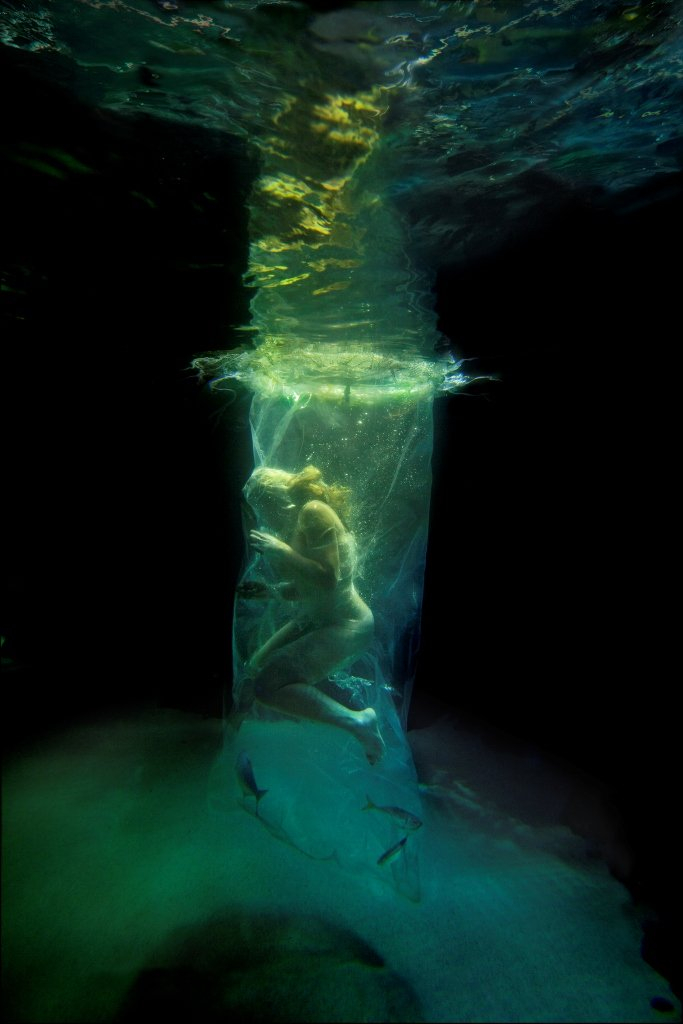Our most iconic movie director has reinvented himself as an artist, transforming some of the themes that have populated his films into video installations, photography, and paintings. At the Govett Brewster last December, the works were housed in one location under the title Breath – the fleeting intensity of life. The disciplines have been split for the Auckland incarnation, with Inhale: moving image at the Gus Fisher, and Exhale: two dimensional works at the Pah Homestead. This review focuses on the video works, though there's plenty of painterly language in the moving image.
Let's start with the showstopper. The Gus Fisher atrium has been painted black, except for the magnificent decorative domed ceiling, which now frames a video screen. Like a Baroque ceiling painting of an apotheosis—in which the faithful below saw nothing but a pair of foreshortened feet disappearing into a puff of cloud—viewers at the Gus Fisher see a naked swimmer/dancer/diver struggle in water. High above, this could be an angel wrestling internal demons. Samantha Morton's face appears, eyes closed, hair wet as she drifts in water; she looks as timelessly demure as Leonardo's Virgin of the Rocks.
Two rooms lead off the atrium, both containing multiple hanging, gauzy screens. Ward has created a densely layered viewing experience in which action is only ever partially visible, fading in and out of blackness; blurry, obscured, tantalising. The ubiquitous naked female form thrashes underwater in slow motion. She appears to be wrapped in clear plastic, so there are several layers between the viewer and the viewed: membrane, water, camera, screen. Her red hair streams like seaweed, and live fish swim through bubbles and tangled limbs.

Born in a Caul (2011) Vincent Ward, photograph, pigment inks on archival paper
Though the majority of Inhale's imagery is watery, there are some highly colourised moments. Underwater lights flare into bright yellow spots; against all this blue it's almost like the Starry Night palette of that other Vincent. This comparison isn't so off key, given the snippets of motion painting from What Dreams May Come (1998) that surface occasionally. The violet lyre bird which scampers through a heavily impastoed undergrowth has its precedent in the painted villages of Kurosawa's homage to Van Gogh in Dreams (1990), while its lineage continues in the fluorescent forests of James Cameron's Avatar (2009). Even the fabric screens bestow a painterly texture to Ward's footage: like a Tony Fomison on heavy jute, and just as emotionally loaded.
A haunting soundtrack fades in and out with the images: crashing, bubbling water mingles with keening violins, barely audible song, long drawn out breaths, and moments of eerie silence. In these calm interludes, when the dense layering subsides temporarily, I'm reminded of Bill Viola's classic video works which explore the human body underwater, including The Messenger from 1996 (which showed at the New Dowse in 2010). Interestingly, both artists claim a near-drowning incident as children to be the inspiration behind their obsession with filming the body under water.

Embryo (2011) Vincent Ward, photograph, pigment inks on archival paper
Ward isn't the only local video artist whose work nods to the American master. Rachael Rakena's Rerehiko (2002) features her iwi's Kapa Haka group performing underwater: an uncanny spin on culture and the ties that bind. Aniwaniwa, her 2007 collaboration with Brett Graham, referred to the flooding of a powerstation in 1947 in order to create Lake Karapiro. Haunting images of submerged workers, trees and powerlines pay homage to the sacred sites of local iwi that were lost forever.
Leilani Kake has also used the submerged figure in her video installations. Ariki (2007) features her young son swimming, wrapped in his own long hair. The video is projected onto the floor, into a tray of real water, flickering reflected light. And, using the calm, frontal compositions of her hero Viola, Kake persuaded four Pacific women to bare all in the water, confronting issues around nudity, shame and Pacific women's health in Nga Hau e Wha (2011).
This list of comparisons may seem digressive, but it's necessary whakapapa. Ward is not the first video artist hereabouts to make sumptuous underwater drama. While Ward has made spectacular cinematic use of indigenous women in Rain of the Children (2008), these indigenous women (Rakena and Kake) make their own spectacular cinema. This is not to diminish the cathartic power of Ward's dreamscapes, but to acknowledge their place in a wider visual discourse. For my part, I am less interested in Ward's waterlogged theatre of the embattled soul, finding more joy and potential in his psychedelic landscapes: where paint meets celluloid to create a third space of the mind.
